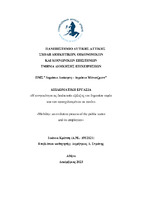| dc.contributor.advisor | Στράνης, Δημήτριος | |
| dc.contributor.author | Κρέτση, Ιωάννα | |
| dc.date.accessioned | 2024-04-29T10:43:04Z | |
| dc.date.available | 2024-04-29T10:43:04Z | |
| dc.date.issued | 2024-04-24 | |
| dc.identifier.uri | https://polynoe.lib.uniwa.gr/xmlui/handle/11400/6662 | |
| dc.identifier.uri | http://dx.doi.org/10.26265/polynoe-6498 | |
| dc.description.abstract | Η παρούσα εργασία μελετά την κινητικότητα στο ελληνικό διοικητικό σύστημα ως διαδικασία εξέλιξης του δημοσίου τομέα και των απασχολουμένων σε αυτόν. Χαρτογραφεί την κινητικότητα από τον πρώτο μεταπολεμικό Υπαλληλικό Κώδικα (Υ.Κ.) έως την εισαγωγή του Ενιαίου Συστήματος Κινητικότητας (Ε.Σ.Κ.) και τις τελευταίες εξελίξεις. Ωστόσο, η ανάλυση δεν περιορίζεται στη μελέτη του Κώδικα, αλλά επιχειρεί σύνδεση του θεσμικού πλαισίου με τις αρχές της σύγχρονης διοικητικής επιστήμης, υπό το πρίσμα των προκλήσεων του σύγχρονου περιβάλλοντος. Αρχικά, αποτυπώνεται η αρχιτεκτονική του συστήματος κινητικότητας που καθιέρωσαν οι δύο προϊσχύοντες Κώδικες, και ακολούθως, ο ισχύων Υ.Κ. του ν.3528/2007 (όπως πρωτοεφαρμόστηκε). Στη συνέχεια, παρατίθενται οι μεταβολές στις αρχές της δεκαετίας του 2010, όπου τα προγράμματα κινητικότητας τέθηκαν στο επίκεντρο της διοικητικής μεταρρύθμισης. Σημαντικός σταθμός στην ελληνική δημοσία διοίκηση, και στην παρούσα εργασία, είναι το Ε.Σ.Κ, που αναλύεται σε βάθος, και αποτυπώνεται το σύστημα όπως ισχύει σήμερα. Παρουσιάζεται ανάλυση των επίσημων στατιστικών στοιχείων για όλους τους κύκλους του Ε.Σ.Κ, έως τώρα, και επιπλέον, περαιτέρω επεξεργασία τους βάσει της ταξινόμησης του Μητρώου των Φορέων της Γενικής Κυβέρνησης που τηρείται από την Ελληνική Στατιστική Υπηρεσία (ΕΛ.ΣΤΑΤ). Τέλος, παρουσιάζονται τα συμπεράσματα της εργασίας σχετικά με την εξέλιξη της αρχιτεκτονικής της κινητικότητας των εργαζομένων στην ελληνική δημόσια διοίκηση, και αναδεικνύονται οι προκλήσεις που συνεπάγεται η αναζήτηση του κατάλληλου υποψηφίου για την κατάλληλη θέση, για την αντιμετώπιση των σύνθετων προβλημάτων δημόσιας πολιτικής. | el |
| dc.format.extent | 94 | el |
| dc.language.iso | el | el |
| dc.publisher | Πανεπιστήμιο Δυτικής Αττικής | el |
| dc.rights | Αναφορά Δημιουργού - Μη Εμπορική Χρήση - Παρόμοια Διανομή 4.0 Διεθνές | * |
| dc.rights.uri | https://creativecommons.org/licenses/by-nc-sa/4.0/deed.el | * |
| dc.subject | Κινητικότητα | el |
| dc.subject | Ενιαίο Σύστημα Κινητικότητας | el |
| dc.subject | Μετάταξη | el |
| dc.subject | Απόσπαση | el |
| dc.subject | Διοίκηση ανθρωπίνων πόρων | el |
| dc.title | Η κινητικότητα ως διαδικασία εξέλιξης του δημοσίου τομέα και των απασχολουμένων σε αυτόν | el |
| dc.title.alternative | Mobility: an evolution process of the public sector and its employees | el |
| dc.type | Μεταπτυχιακή διπλωματική εργασία | el |
| dc.contributor.committee | Μάνθος, Απόστολος | |
| dc.contributor.committee | Κομισόπουλος, Φαίδων | |
| dc.contributor.faculty | Σχολή Διοικητικών, Οικονομικών & Κοινωνικών Επιστημών | el |
| dc.contributor.department | Τμήμα Διοίκησης Επιχειρήσεων | el |
| dc.contributor.master | Δημόσια Διοίκηση – Δημόσιο Μάνατζμεντ | el |
| dc.description.abstracttranslated | This paper studies the mobility in the Greek administrative system as a process of evolution of the public sector and its employees. It maps mobility from the first post-war Civil Servants Code to the introduction of the Unified Mobility System, and the latest developments. However, the analysis is not limited to the study of the Code, but attempts to link the institutional framework with the principles of modern administrative science, in the light of the challenges of the contemporary environment. Initially, the study presents the architecture of the mobility system established by the two previous Codes, followed by the current Civil Servants Code of Law 3528/2007 (the first implementation of the Code). Then, it focuses on the changes in the early 2010s, when mobility became the focus of the administrative reform. Next, the Unified Mobility System is analysed in depth, as in force, an important milestone in the Greek public administration and in this paper. The study presents an analysis of the official statistical data for all the mobility cycles of the Unified Mobility System so far, and through a further data analysis on the basis of the classification of the Register of General Government Agencies, maintained by the Hellenic Statistical Authority (ELSTAT). Finally, the conclusions of the study are presented regarding the evolution in the architecture of employee mobility in the Greek public administration. The study highlights the challenges that are associated with finding the right candidate for each position, to address complex public policy problems. | el |


